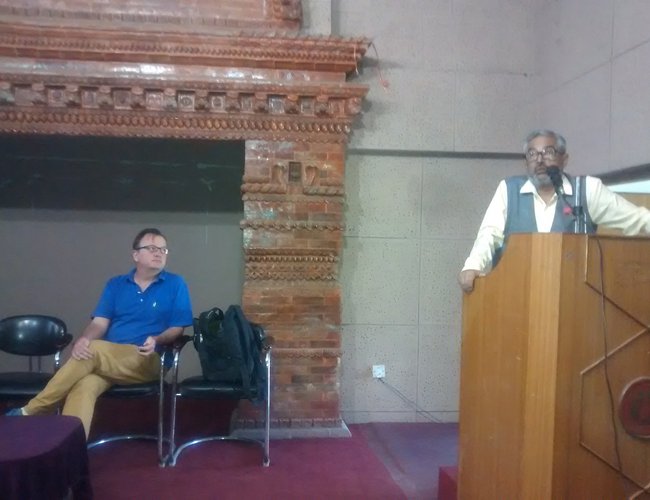
With extreme events occurring regularly, floods are creating havoc to the people living in different parts of Nepal, including the Himalayan region. Although INGOs like Practical Action have been implementing early warning systems in the mid-western Nepal, particularly the Karnali basin, flood devastation is yet to come under control.
With the introduction of community-based early warning system, linking it with mobile phone and community radio from sources of river up to flood affected plains, Practical Action’s early warning system has reduced the fatality and damage.
At a programme organised by Nepal Academy of Science and Technology (NAST) and Nepal Water Conservation Foundation (NWCF) under 49thPaniSatsang, Prof. Hugh Sinclair, University of Edinburgh, was using geomorphology to resolve extreme flood risk in the Himalaya and explaining how floods are creating havoc in the plain.
Moderated by Dipak Gyawali, chairman of the NWCF, the half-an-hour presentation of professor Hugh went to show how the Himalayan rivers are complicated and complex to understand.
Based on studies in the Indian State of Uttarakhand and Laddakh, as well as in Karnali, professor Hugh said that the rivers are very strong and carry huge sedimentation and deposit it to the plane.
Flood risk as a concept requires knowledge of the history of extreme events as well as that of the downstream cascade of processes that follow on from these events. The first question that needs addressing is ‘what is the time interval of sampling required to have a full appreciation of the range of extreme events that may impact a region?’ Secondly, ‘what are the downstream instabilities and recovery time for extreme events?’
His current research projects include dynamic topographies and flood risk in the Tarai, Nepal; gravel-sand transitions in the rivers draining the Himalaya, and impact on flood risk; sediment budgets and recycling in the rivers of Great Plains, Nebraska, US; post-orogenic landscape evolution of the Carpathian mountain range; post-orogenic landscapes of the Pyrenees; and other collaborations on Tibetan landscapes with Chinese colleagues.
“The first can be resolved by looking at well dated geomorphological and sedimentological records of processes and events in the landscape. As an example, we analyse the extensive flooding of the western Himalaya in 2010 in the Indus Valley in Ladakh, NW India, where we were able to demonstrate that the use of the TRMM satellite data was wildly inaccurate in locating the event, and that the event represented a convective system with a >3000 year recurrence interval,” said Professor Hugh.
“Analysing the devastating floods in Uttarakhand in 2013, we demonstrated that it was the biggest flood there since the last glacial maximum 13,000 years ago. Because climate linked changes in monsoon precipitation patterns will also change extreme event, learning from these events will help identify potential future impacts,” said Professor Hugh.
“The ongoing monitoring of the geomorphic impact of the 2015 Gorkha earthquake is helping us develop models that not only include hydraulic flow, but incorporate changes in sediment yield and dispersal that impact downstream flood risk in the Terai regions of Nepal.
Hugh Sinclair, Professor of Surface Geodynamics, School of Geosciences, University of Edinburgh, received his BSc Hons in Geology from University College Wales and DPhil from Oxford University.
Summing up the program, Gyawali said that the nature of Himalayan rivers is different from other rivers originating in the mid hills and Chure range. “Himalayan rivers are more powerful and stronger than those other rivers,” said Gyawali.
Although early warning system is implemented in Nepal by organizations like Practical Action, it is available in a very small scale. In that context, the program was useful to teach the people how to get ready to brace for floods at times of crisis.
- MELAMCHI WATER SUPPLY: No Interruption During Monsoon
- Jun 25, 2025
- KOREAN RETURNEES: Successful Integration
- Jun 25, 2025
- UPPER TRISHULI-1: Engaging With Local
- Jun 25, 2025
- IME GROUP: Twenty Five Years Of Journey
- Jun 24, 2025
- NEPAL’S AIR POLLUTION: A Growing Health Concern
- Jun 24, 2025















